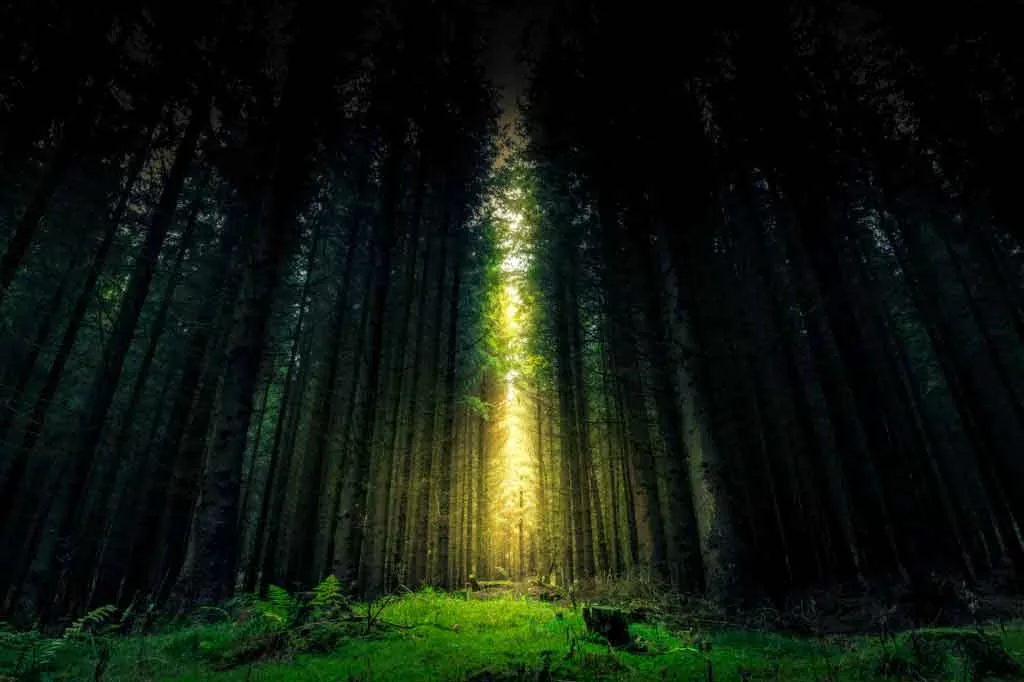In the wild places of Concord linger old Puritan superstitions and Transcendental possibilities. We begin in the year 1620 when, bearing sea-weary Puritan separatists, the Mayflower arrived off Cape Cod’s coast revealing what Pilgrim leader William Bradford noted as “a hideous and desolate wilderness, full of wild beasts.”
To the Puritans, the Wilderness was the devil’s territory. Satan would not linger in the exposed coastal regions where the Puritans first settled and kept him at bay with devout prayer, but he was always there, in the wild forests, the swamps, the unexplored places, tempting them to leave the seaside settlements of early Massachusetts and stray from righteousness.
In Wilderness dwelt the “feared other”: Native Americans, cougars, bears, wolves, owls, and birds that made noises unfamiliar to the new settlers, and old characters of folklore and superstitions— witches and the devil’s agents. But the woods also offered a freedom from constraints and expectations of daily life. Set in the 1600s town of Salem, Nathaniel Hawthorne’s 1850 The Scarlet Letter conveys this temptation of Wilderness when adulterous Puritan Hester Prynne, seeking to escape from her husband and society’s judgement, appeals to her lover, the Reverend Dimmesdale, to flee with her and their infant child and live in the forest. “Whither leads yonder forest track? Backwards to the settlement, thou sayest! Yes; but onward too! Deeper it goes, and deeper, into the wilderness, less plainly to be seen at every step! …There thou art free!”
In real life, freedom in Wilderness did hold appeal. In 1634, fur trader Simon Willard, a Puritan recently arrived from Kent, England, explored the unknown places beyond Boston. Twenty miles to the west, he came across Musketaquid, a Native American settlement of cleared fields and riverways. With Puritan Minister Peter Bulkeley, Willard arranged for Musketaquid’s purchase from the Algonquin tribe. Renamed Concord, the town was officially founded in 1635 as America’s first inland settlement.
Generations passed; more inland towns were established in once-wild places, their history passed down by word of mouth and through the writings of people like Massachusetts’s minister Cotton Mather (1663-1728) who wrote, “The New-Englanders, are a people of God settled in those which were once the Devil’s territories…. Truly, our wilderness hath been the place of dragons.”
 ©istock.com/TrevorRousselle
©istock.com/TrevorRousselleBy the early-mid 19th century, Concord was inhabited by writers Ralph Waldo Emerson (the 5th-great-grandson of the Reverend Peter Bulkeley), Henry David Thoreau, and Nathaniel Hawthorne.
Like many of his ancestors, Emerson, a graduate of Harvard, was also a minister, but after the death of his first wife Ellen Tucker in 1831, he questioned his faith and left his pulpit. He traveled to Europe where he met writers/philosophers Thomas Carlyle, Samuel Coleridge, and William Wordsworth. Inspired by their ideas, he returned to Concord and lived briefly in his family’s home, the Old Manse. There, in 1834, in an upstairs bedroom, his desk placed by a window overlooking the Old North Bridge behind the house, Emerson drafted his essay “Nature”. In it, Emerson asks why should we view the world through the eyes of our forefathers and not our own? “Why should not we also enjoy an original relation to the universe? …the sun shines today also…there are new lands, new men, new thoughts.” In “Nature” Emerson turns dramatically from the Puritan view of Wilderness as something full of evil, instead presenting the natural world as a place to find God. Wrote Emerson, “In the woods, we return to reason and faith. There I feel that nothing can befall me in life, — no disgrace, no calamity…which nature cannot repair. Standing on the bare ground, my head bathed by the blithe air, and uplifted into infinite space, all mean egotism vanishes. I become a transparent eye-ball; I am nothing; I see all; the currents of the Universal Being circulate through me; I am part or particle of God.”
Published in 1836, “Nature” shared the foundation for transcendentalism’s tenets of God being found in the combination of man, nature, and spirit, free of the confines of a church doctrine and open to the influence of the mysterious unknown. “Nature” contributed to Emerson’s establishment as the founder of American Transcendentalism and was read far and wide, including by Harvard student and fellow Concordian, Henry David Thoreau.
In his essay “Walking” (aka “The Wild”, published 1862) Thoreau writes, “How near to good is what is wild! …Hope and the future for me are not in lawns and cultivated fields, not in towns and cities, but in the impervious and quaking swamps.” To Thoreau, the Puritan’s devil was not found in the wilderness, but rather in its destruction, for the ruin of nature was the destruction of heaven. He wrote, “Nowadays almost all man’s improvements, so called, as the building of houses and the cutting down of the forest and of all large trees, simply deform the landscape…. I saw… some worldly miser with a surveyor looking after his bounds, while heaven had taken place around him, and he did not see the angels going to and fro…. I looked again and saw him standing in the middle of a boggy Stygian fen, surrounded by devils… and I saw that the Prince of Darkness was his surveyor.” Where the Puritans feared destruction and moral downfall in the Wilderness, Thoreau saw salvation, writing, “In Wildness is the preservation of the world.”
As American Transcendentalism began to grow in Concord, Nathaniel Hawthorne arrived just in time to recapture the fading Puritan memory of Wilderness’s doom and gloom. Following his wedding, Hawthorne rented the Old Manse from 1842-45. In the same room in which Emerson previously wrote “Nature”, Hawthorne compiled a series of short stories into Mosses from an Old Manse. Unlike Emerson, Hawthorne built his desk against the wall, sitting with his back to the windows, perhaps an appropriate move for penning stories set in the times of his own Puritan ancestor, John Hathorne, “the hanging judge” of the Salem Witch Trials. Set in 1600s Massachusetts and in landscapes easily imaginable as Concord or Salem, the temptation of Wilderness pulls strongly on Hawthorne’s characters including driving a young man into guilty-paranoia over an act committed in the woods (“Roger Malvin’s Burial”) and luring a young Puritan bride to devil-worship in the night forest (“Young Goodman Brown”). In the latter tale, “maddened with despair”, the bride’s husband pursues her and plunges into the woods “leaving him in the heart of the dark wilderness, still rushing onward with the instinct that guides mortal man to evil.”
By the 1840s, “rushing onward [through] the dark wilderness”, the Fitchburg Railroad line cut through Concord, part of its track running by Walden Pond where Thoreau lived from 1845-47. Cotton Mather’s “dragons” of old New England transformed into Thoreau’s “Iron horse… snort[ing] like thunder, shaking the earth with his feet and breathing fire and smoke from his nostrils… [a] fiery dragon they will put into new Mythology” [Walden, Ch. 17].
The modern world was slowly clearing space in Concord, pushing old Puritan fears of Wilderness deeper into the past and the remaining wild places for which Thoreau and other transcendentalists advocated. Wrote Thoreau in Walden, “We need the tonic of wildness… we require that all things be mysterious and unexplorable, that land and sea be infinitely wild, unsurveyed and unfathomed by us…. We can never have enough of Nature” or an eternal temptation of Wilderness.


